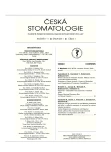Dental Erosions - Part 1.
Authors:
J. Morozova
Authors‘ workplace:
Klinika zubního lékařství LF UP a FN, Olomouc
Published in:
Česká stomatologie / Praktické zubní lékařství, ročník 111, 2011, 1, s. 4-13
Category:
Overview
Taking into account that dental caries is still the most prevalent disease of oral cavity in the modern time we meet hard dental tissues erosions very frequently. Tooth erosions are characterized as irreversible progressive loss of hard dental tissues on the tooth surface caused by acids whose source is formed from another substance different from mouth bacteria in contrast to caries. These acids are extrinsic (from food, beverages, some drugs, oral hygiene products and environment) or intrinsic (gastric acid). Another erosive risk factors are little amount and low pH of saliva, insufficient influx of fluoride, calcium and phosphate. The aim of the review is tendency to describe prevalence, basic origins of tooth erosions and mechanism of their development.
Key words:
erosion of teeth - prevalence of dental erosions - etiology of dental erosions - chemical factors
Sources
1. Amaechi, B. T.: Approaches for prevention & control of dental erosion [online] [cit. 2010-07-05]. Dostupný z WWW: <http://www.cappmea. com/courses/downloads/.../approaches_for_ prevention.pdf>.
2. Attin, T.: Čím se od sebe liší erozivní poškození tvrdé zubní struktury a zubní kaz? Prophylaxis Dialogue. Zvláštní vydání o erozi, 2009/2010, s. 7-9.
3. Bernard, G. N. S., Bartlett, D. W., Nigel, D. R.: The prevalence, etiology and management of tooth wear in the United Kingdom. The Journal of Prosthetic Dentistry, roč. 78, 1997, 4, s. 367-372.
4. Boland, T. W.: Dental erosion: more acid means fewer teeth. New South Wales Public Health Bulletin, roč. 10, 1999, 4, s. 35-38.
5. Čečetková, A., Ondrašovičová, J., Petrášová, A.: Acquired changes in hard tooth tissue I. Erosion. Stomatolog, roč. 2, 2007, 17, s. 28-31.
6. Eisenburger, M., Addy, M.: Evaluation of pH and erosion time on demineralisation. Clinical Oral Investigations, 5, 2001, 2, s. 108-111.
7. El-Lababidi, A.: Cervikální defekty-co o nich víme? StomaTeam, 3, 2009, s. 6-10.
8. Gandara, K., Truelove, E. L.: Diagnosis and management of dental erosion. The Journal of Contemporary Dental Practice, roč. 1, 1999, 1, s. 1-17.
9. Grippo, J. O., Simring, M., Schreiner, S.: Attrition, abrasion, corrosion and abfraction revisited. A new perspective on tooth surface lesions. J. Am. Dent. Assoc., 135, 2004, s. 1109-1118.
10. Jensdottir, T., Arnadottir, I. B., Bardow, A., Gudmundsson, K., Theodors, A., Holbrook, W. P.: Relationship between dental erosion, soft drink consumption and gastroesophageal reflux among Icelanders. Clinical Oral Investigations, 8, 2004, 2, s. 91-96.
11. Larsen, M. J., Nyvad, B.: Enamel erosion by some soft drinks and orange juices relative to their pH, buffering effect and contents of calcium phosphate. Caries Research, 33, 1999, s. 81-87.
12. Lussi, A.: Erosion tooth wear. Workshop. Bern, April, 2010.
13. Lussi, A.: Eroze zubů: vyšetření, diagnóza, rizikové faktory. Prophylaxis Dialogue. Zvláštní vydání o erozi. 2009/2010, s. 13-16.
14. Lussi, A., Addy, M., Angmar-Mansson, B. et al.: Dental erosion from diagnosis to therapy. Basel, Karger, 2006. s. 1–2, 6, 10, 67-69, 79-80, 83, 89-91, 101, 107-108, 113-117, 121, 130-135.
15. Lussi, A., Jaeggi, T., Zero, D.: The role of diet in the etiology of dental erosion. Caries Research, 38, 2004, 1, s. 34-44.
16. Mahoney, E. K., Kilpatrick, N. M.: Dental erosion. Part 1. Aetiology and prevalence of dental erosion. New Zealand Dental Journal, 99, 2003, 2, s. 33-41.
17. Machado, C., Lacefield, W., Catledge, A.: Human enamel nanohardness, elastic modulus and surface integrity after beverage contact. Braz. Dent. J., 19, 2008, 1, s. 68-72.
18. Martin, C. W., Edeer, D.: Occupational dental erosion. WorkSafeBC Evidence‐– Based Practice Group, Vancouver, February 2010, [online] [cit. 2010-05-20] Dostupný z WWW: <http://www. worksafebc.com/health_care_providers/Assets/PDF/occupational_dental_erosion.pdf >
19. Rugg-Gunn, A. J., Maguire, A., Gordon, P. H., McCabe, J. F., Stephenson, G.: Comparison of erosion of dental enamel by four drinks using an intra-oral applicance. Caries Research, 32, 1998, 5, s. 344-350.
20. Stejskalová, J.: Konzervační zubní lékařství. 2. vydání. Praha, Galén, 2008, s. 21.
21. Vambera, M., Gojišová, E.: Atrice, abraze, koroze a abfrakce. Nový pohled na povrchové léze zubů. Čes. Stomat., roč. 107, 2007, č. 6, s. 165-168.
22. Wiegand, A.: Rizikové faktory a pokyny k posouzení rizik. Prophylaxis dialogue. Zvláštní vydání o erozi. 2009/2010, s. 17-19.
23. http://www.who.int/substance_abuse/publications/en/czech_republic.pdf
24. http://is.muni.cz/th/65324/fss_b/bakpsy.doc
Labels
Maxillofacial surgery Orthodontics Dental medicineArticle was published in
Czech Dental Journal

2011 Issue 1
- What Effect Can Be Expected from Limosilactobacillus reuteri in Mucositis and Peri-Implantitis?
- The Importance of Limosilactobacillus reuteri in Administration to Diabetics with Gingivitis
Most read in this issue
- Methods of Caries Incipient Well-timed Diagnostics
-
Retence horních středních řezáků
Příčiny retence a srovnání možností léčby - Dental Erosions - Part 1.
- Segner-Hasund Harmony Box in Clinical Practice
